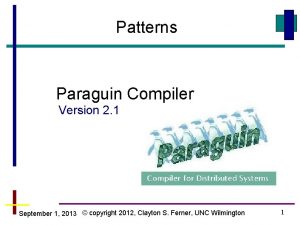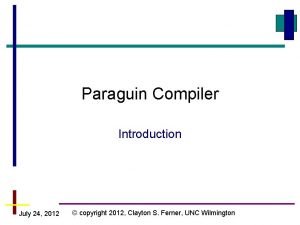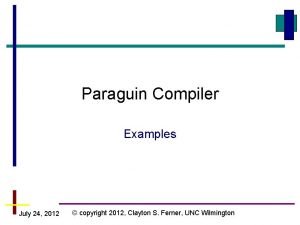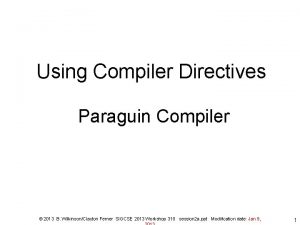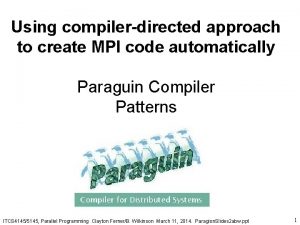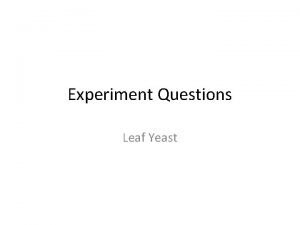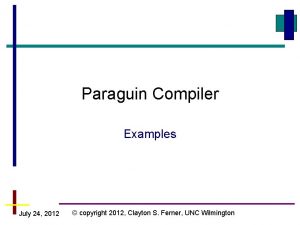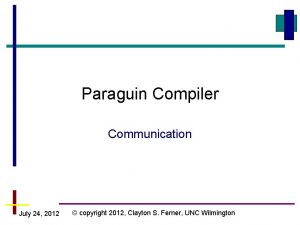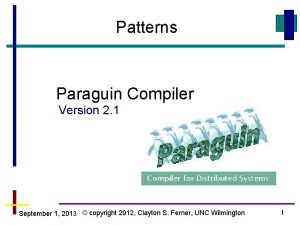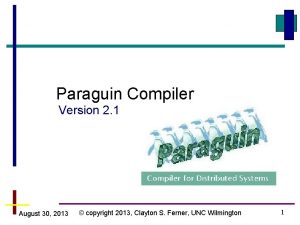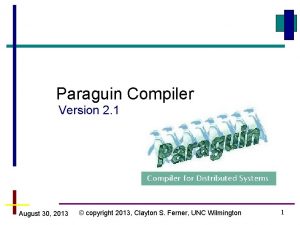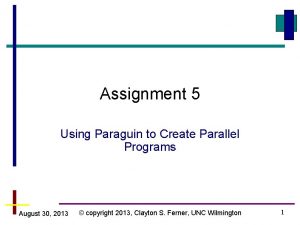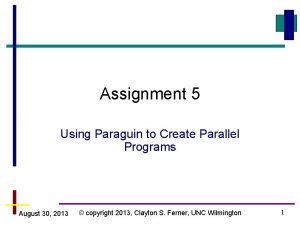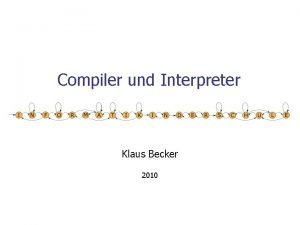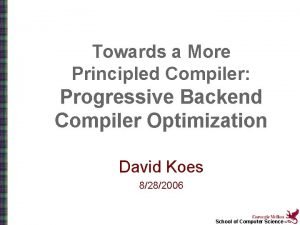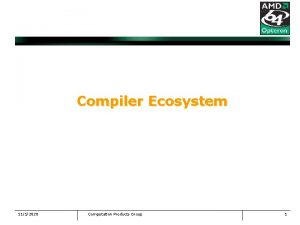Paraguin Compiler Examples July 24 2012 copyright 2012









![Matrix Addition (complete) print_results(char *prompt, float a[N][N]) { int i, j; printf ("nn%sn", prompt); Matrix Addition (complete) print_results(char *prompt, float a[N][N]) { int i, j; printf ("nn%sn", prompt);](https://slidetodoc.com/presentation_image_h/044f3c181cf0d3b5540e968f198274da/image-10.jpg)























![; #pragma paraguin begin_parallel perm[0] = 0; min. Dist = -1. 0; if (n ; #pragma paraguin begin_parallel perm[0] = 0; min. Dist = -1. 0; if (n](https://slidetodoc.com/presentation_image_h/044f3c181cf0d3b5540e968f198274da/image-34.jpg)




![Sobel Edge Detection Algorithm /* 3 x 3 Sobel masks. */ GX[0][0] = -1; Sobel Edge Detection Algorithm /* 3 x 3 Sobel masks. */ GX[0][0] = -1;](https://slidetodoc.com/presentation_image_h/044f3c181cf0d3b5540e968f198274da/image-39.jpg)



- Slides: 42

Paraguin Compiler Examples July 24, 2012 © copyright 2012, Clayton S. Ferner, UNC Wilmington

Examples Matrix Addition (the complete program) Traveling Salesman Problem (TSP) Sobel Edge Detection July 24, 2012 © copyright 2012, Clayton S. Ferner, UNC Wilmington

Matrix Addition The complete program July 24, 2012 © copyright 2012, Clayton S. Ferner, UNC Wilmington

Matrix Addition (complete) #define N 512 #ifdef PARAGUIN typedef void* __builtin_va_list; extern int MPI_COMM_WORLD; extern int MPI_Barrier(); #endif #include <stdio. h> #include <math. h> #include <sys/time. h> print_results(char *prompt, float a[N][N]); int main(int argc, char *argv[]) { int i, j; float a[N][N], b[N][N], c[N][N]; char *usage = "Usage: %s filen"; FILE *fd; July 24, 2012 © copyright 2012, Clayton S. Ferner, UNC Wilmington

Matrix Addition (complete) double elapsed_time; struct timeval tv 1, tv 2; if (argc < 2) { fprintf (stderr, usage, argv[0]); return -1; } if ((fd = fopen (argv[1], "r")) == NULL) { fprintf (stderr, "%s: Cannot open file %s for reading. n", argv[0], argv[1]); fprintf (stderr, usage, argv[0]); return -1; } July 24, 2012 © copyright 2012, Clayton S. Ferner, UNC Wilmington

Matrix Addition (complete) // // // Read input from file for matrices a and b. The I/O is not timed because this I/O needs to be done regardless of whether this program is run sequentially on one processor or in parallel on many processors. Therefore, it is irrelevant when considering speedup. for (i = 0; i < N; i++) for (j = 0; j < N; j++) fscanf (fd, "%f", &a[i][j]); for (i = 0; i < N; i++) for (j = 0; j < N; j++) fscanf (fd, "%f", &b[i][j]); July 24, 2012 © copyright 2012, Clayton S. Ferner, UNC Wilmington

Matrix Addition (complete) #ifdef PARAGUIN ; #pragma paraguin begin_parallel // This barrier is here so that we can take a time stamp // Once we know all processes are ready to go. MPI_Barrier(MPI_COMM_WORLD); #pragma paraguin end_parallel #endif // Take a time stamp gettimeofday(&tv 1, NULL); ; #pragma paraguin begin_parallel // Broadcast the input to all processors. This could be // faster if we used scatter, but Bcast is easy and scatter // is not implemented in Paraguin #pragma paraguin bcast a b July 24, 2012 © copyright 2012, Clayton S. Ferner, UNC Wilmington

Matrix Addition (complete) // Parallelize the following loop nest assigning iterations // of the outermost loop (i) to different partitions. #pragma paraguin forall C p i j 0 x 0 -1 1 0 x 0 0 x 0 1 -1 0 x 0 // We need to gather all values c[i][j]. So we can just // use i, j => 0. #pragma paraguin gather 0 x 0 C 0 x 0 i 0 x 0 j 0 x 0 for (i = 0; i < N; i++) { for (j = 0; j < N; j++) { c[i][j] = a[i][j] + b[i][j]; } } July 24, 2012 © copyright 2012, Clayton S. Ferner, UNC Wilmington

Matrix Addition (complete) ; #pragma paraguin end_parallel // Take a time stamp. This won't happen until after the master // process has gathered all the input from the other processes. gettimeofday(&tv 2, NULL); elapsed_time = (tv 2. tv_sec - tv 1. tv_sec) + ((tv 2. tv_usec - tv 1. tv_usec) / 1000000. 0); printf ("elapsed_time=t%lf (seconds)n", elapsed_time); // print result print_results("C = ", c); } July 24, 2012 © copyright 2012, Clayton S. Ferner, UNC Wilmington
![Matrix Addition complete printresultschar prompt float aNN int i j printf nnsn prompt Matrix Addition (complete) print_results(char *prompt, float a[N][N]) { int i, j; printf ("nn%sn", prompt);](https://slidetodoc.com/presentation_image_h/044f3c181cf0d3b5540e968f198274da/image-10.jpg)
Matrix Addition (complete) print_results(char *prompt, float a[N][N]) { int i, j; printf ("nn%sn", prompt); for (i = 0; i < N; i++) { for (j = 0; j < N; j++) { printf(" %. 2 f", a[i][j]); } printf ("n"); } printf ("nn"); } July 24, 2012 © copyright 2012, Clayton S. Ferner, UNC Wilmington

Matrix Addition After compiling with the command: This produces: runparaguin matrixadd. c matrixadd. out. c (source with MPI) matrixadd. out (compiled with mpicc) (Demonstration) July 24, 2012 © copyright 2012, Clayton S. Ferner, UNC Wilmington

Partitioning Reviewed #pragma paraguin forall p -1 1 i 1 -1 j 0 x 0 The expression above assigns each iteration of the i loop to its own partition (p = i). We could also partition along the j loop: #pragma paraguin forall C 0 x 0 p -1 1 i 0 x 0 j 1 -1 Or would could have many other partitions July 24, 2012 © copyright 2012, Clayton S. Ferner, UNC Wilmington

Partitioning Reviewed The partitioning is a system of inequalities written in matrix/vector form: where July 24, 2012 is a matrix, and are vectors. © copyright 2012, Clayton S. Ferner, UNC Wilmington

Partitioning Reviewed So the partition expressed in the pragma: #pragma paraguin forall C 0 x 0 Represents the following: July 24, 2012 p -1 1 i 1 -1 © copyright 2012, Clayton S. Ferner, UNC Wilmington j 0 x 0

Partitioning Reviewed If we multiply this out: We get: July 24, 2012 © copyright 2012, Clayton S. Ferner, UNC Wilmington

Partitioning Reviewed Now simplify: July 24, 2012 © copyright 2012, Clayton S. Ferner, UNC Wilmington

Partitioning Reviewed #pragma paraguin forall C 0 x 0 p -1 1 j i 1 -1 j 0 x 0 p=i p=11 p=10 p=9 p=8 p=7 p=6 p=5 p=4 p=3 p=2 p=1 p=0 July 24, 2012 i © copyright 2012, Clayton S. Ferner, UNC Wilmington

Partitioning Reviewed So the partition expressed in the pragma: #pragma paraguin forall C 0 x 0 Represents the following: July 24, 2012 p -1 1 i 0 x 0 © copyright 2012, Clayton S. Ferner, UNC Wilmington j 1 -1

Partitioning Reviewed If we multiply this out: We get: July 24, 2012 © copyright 2012, Clayton S. Ferner, UNC Wilmington

Partitioning Reviewed Now simplify: July 24, 2012 © copyright 2012, Clayton S. Ferner, UNC Wilmington

Partitioning Reviewed #pragma paraguin forall C 0 x 0 p -1 1 i 0 x 0 j 1 -1 p=11 p=10 p=9 p=8 p=7 p=6 j p=5 p=4 p=3 p=j p=2 p=1 p=0 i July 24, 2012 © copyright 2012, Clayton S. Ferner, UNC Wilmington

Partitioning Reviewed Let’s say we want to partition using p=i+j We actually have to go the other direction July 24, 2012 © copyright 2012, Clayton S. Ferner, UNC Wilmington

Partitioning Reviewed July 24, 2012 © copyright 2012, Clayton S. Ferner, UNC Wilmington

Partitioning Reviewed To write this as a pragma: #pragma paraguin forall July 24, 2012 C 0 x 0 p -1 1 i 1 -1 © copyright 2012, Clayton S. Ferner, UNC Wilmington j 1 -1

Partitioning Reviewed #pragma paraguin forall 23 2 p= =2 21 p 0 p= 2 9 p= 1 8 p= 1 7 p= =1 6 p 1 p= 15 4 p= 1 3 p= =1 2 p 1 p= 11 0 p= 1 p= =9 p 8 p= =7 p 6 p= =5 p 4 p= =3 p 2 p= =1 p j C 0 x 0 July 24, 2012 p -1 1 i 1 -1 j 1 -1 p=i+j i © copyright 2012, Clayton S. Ferner, UNC Wilmington

Traveling Salesman Problem (TSP) July 24, 2012 © copyright 2012, Clayton S. Ferner, UNC Wilmington

The Traveling Salesman Problem is simply to find the shortest circuit (Hamiltonian circuit) that visits every city in a set of cities at most once July 24, 2012 © copyright 2012, Clayton S. Ferner, UNC Wilmington

This problem falls into the class of “NP-hard” problems What that means is that there is no known “polynomial” time (“big-oh” of a polynomial) algorithm that can solve it The only know algorithm to solve it is to compare the distances of all possible Hamiltonian circuits. But there are N! possible circuits of N cities. July 24, 2012 © copyright 2012, Clayton S. Ferner, UNC Wilmington

Yes heuristics can be applied to find a “good” solution fast, but there’s no guarantee it is the best The “brute force” algorithm is to consider all possible permutations of the N cities First we’ll fix the first city since there are N equivalent circuits where we rotate the cities We will consider the reverse directions to be different circuits but that’s hard to account for July 24, 2012 © copyright 2012, Clayton S. Ferner, UNC Wilmington

If we number the cities from 0 to N-1, and 0 is the origination city, then the possible permutations of 4 cities are: 0 ->1 ->2 ->3 ->0 0 ->1 ->3 ->2 ->0 0 ->2 ->3 ->1 ->0 0 ->2 ->1 ->3 ->0 0 ->3 ->1 ->2 ->0 0 ->3 ->2 ->1 ->0 July 24, 2012 Notice that there are some permutations that are the reverse of other. These are equivalent permutations. Since we are fixing origination city, there are (N-1)! permutations. © copyright 2012, Clayton S. Ferner, UNC Wilmington

We can compute the distances between all pairs of locations (O(N 2)) This is the input City 0 City 1 City 2 City 3 City 0 0 77. 301157 66. 648884 10. 524875 City 1 77. 301157 0 71. 335061 79. 977022 City 2 66. 648884 71. 335061 0 59. 265103 City 3 10. 524875 79. 977022 59. 265103 0 July 24, 2012 © copyright 2012, Clayton S. Ferner, UNC Wilmington

Problem: Iterating through the possible permutations is recursive, but we need a straight forward for loop to parallelize Solution: Use a for loop to assign the first two cities Since city 0 is fixed, there are n-1 choices for city 1 and n-2 choices for city 2 That means there are (n-1)(n-2) = n 2 – 3 n + 2 combinations of the first two cities July 24, 2012 © copyright 2012, Clayton S. Ferner, UNC Wilmington

Assignment of cities 0 -2 N = n*n - 3*n + 2; // (n-1)(n-2) perm[0] = 0; for (i = 0; i < N; i++) { perm[1] = i / (n-2) + 1; perm[2] = i % (n-2) + 1; . . . July 24, 2012 © copyright 2012, Clayton S. Ferner, UNC Wilmington
![pragma paraguin beginparallel perm0 0 min Dist 1 0 if n ; #pragma paraguin begin_parallel perm[0] = 0; min. Dist = -1. 0; if (n](https://slidetodoc.com/presentation_image_h/044f3c181cf0d3b5540e968f198274da/image-34.jpg)
; #pragma paraguin begin_parallel perm[0] = 0; min. Dist = -1. 0; if (n == 2) { perm[1] = 1; // If n == 2, then N == 0, // and we are done. min. Perm[0] = perm[0]; min. Perm[1] = perm[1]; min. Dist = compute. Dist(D, n, perm); } ; #pragma paraguin bcast n #pragma paraguin bcast N #pragma paraguin bcast D July 24, 2012 © copyright 2012, Clayton S. Ferner, UNC Wilmington

#pragma paraguin forall C 0 x 0 p -1 1 N 0 x 0 i 1 -1 for (i = 0; i < N; i++) { perm[1] = i / (n-2) + 1; perm[2] = i % (n-2) + 1; . . . July 24, 2012 © copyright 2012, Clayton S. Ferner, UNC Wilmington

Sobel Edge Detection July 24, 2012 © copyright 2012, Clayton S. Ferner, UNC Wilmington

Sobel Edge Detection Given an image, the problem is to detect where the “edges” are in the picture July 24, 2012 © copyright 2012, Clayton S. Ferner, UNC Wilmington

Sobel Edge Detection July 24, 2012 © copyright 2012, Clayton S. Ferner, UNC Wilmington
![Sobel Edge Detection Algorithm 3 x 3 Sobel masks GX00 1 Sobel Edge Detection Algorithm /* 3 x 3 Sobel masks. */ GX[0][0] = -1;](https://slidetodoc.com/presentation_image_h/044f3c181cf0d3b5540e968f198274da/image-39.jpg)
Sobel Edge Detection Algorithm /* 3 x 3 Sobel masks. */ GX[0][0] = -1; GX[0][1] = 0; GX[0][2] = 1; GX[1][0] = -2; GX[1][1] = 0; GX[1][2] = 2; GX[2][0] = -1; GX[2][1] = 0; GX[2][2] = 1; GY[0][0] = 1; GY[0][1] = 2; GY[0][2] = 1; GY[1][0] = 0; GY[1][1] = 0; GY[1][2] = 0; GY[2][0] = -1; GY[2][1] = -2; GY[2][2] = -1; for(x=0; x < N; ++x){ for(y=0; y < N; ++y){ sumx = 0; sumy = 0; // handle image boundaries if(x==0 || x==(h-1) || y==0 || y==(w-1)) sum = 0; else{ July 24, 2012 Pragmas go here © copyright 2012, Clayton S. Ferner, UNC Wilmington

Sobel Edge Detection Algorithm //x gradient approx for(i=-1; i<=1; i++) for(j=-1; j<=1; j++) sumx += (gray. Image[x+i][y+j] * GX[i+1][j+1]); //y gradient approx for(i=-1; i<=1; i++) for(j=-1; j<=1; j++) sumy += (gray. Image[x+i][y+j] * GY[i+1][j+1]); //gradient magnitude approx sum = (abs(sumx) + abs(sumy)); } edge. Image[x][y] = clamp(sum); } } July 24, 2012 © copyright 2012, Clayton S. Ferner, UNC Wilmington

Sobel Edge Detection Algorithm Inputs (that need to be broadcast or scattered): GX and GY arrays gray. Image array w and h (width and height) There are 4 nested loops (x, y, i, and j) The final answer is the array edge. Image July 24, 2012 © copyright 2012, Clayton S. Ferner, UNC Wilmington

Sobel Edge Detection Algorithm We put these in front of that loop to parallelize it. ; #pragma paraguin begin_parallel These are the inputs #pragma paraguin bcast gray. Image #pragma paraguin bcast w #pragma paraguin bcast h Partition the x loop (outermost loop) #pragma paraguin forall C 0 x 0 p -1 1 x 1 -1 y 0 x 0 Gather all elements of the edge. Image array #pragma paraguin gather July 24, 2012 4 C 0 x 0 x 0 x 0 y 0 x 0 © copyright 2012, Clayton S. Ferner, UNC Wilmington i 0 x 0 j 0 x 0
 Yacc tutorial
Yacc tutorial Cross compiler in compiler design
Cross compiler in compiler design Paraguin
Paraguin Paraguin
Paraguin Paraguin
Paraguin Paraguin
Paraguin Paraguin
Paraguin Dentist copyright 2012
Dentist copyright 2012 Copyright 2012
Copyright 2012 Copyright 2012
Copyright 2012 Copyright 2012
Copyright 2012 The mysteries of harris burdick captain tory
The mysteries of harris burdick captain tory Harris burdick missing in venice
Harris burdick missing in venice July 1-4 1863
July 1-4 1863 Tender mean
Tender mean Ruth bruno
Ruth bruno 2001 july 15
2001 july 15 2003 july 17
2003 july 17 July 30 2009 nasa
July 30 2009 nasa Sources nso july frenchhowell neill technology...
Sources nso july frenchhowell neill technology... May 1775
May 1775 I am silver and exact i have no preconceptions
I am silver and exact i have no preconceptions The cuban melodrama
The cuban melodrama Imagery in poppies in july
Imagery in poppies in july Gdje se rodio nikola tesla
Gdje se rodio nikola tesla Ctdssmap payment schedule july 2021
Ctdssmap payment schedule july 2021 Sergei korolev
Sergei korolev 6th july 1988
6th july 1988 Monday 13th july
Monday 13th july On july 18 2001 a train carrying hazardous chemicals
On july 18 2001 a train carrying hazardous chemicals July 4 sermon
July 4 sermon June too soon july stand by
June too soon july stand by July 2 1937 amelia earhart
July 2 1937 amelia earhart June 22 to july 22
June 22 to july 22 July 12 1776
July 12 1776 The hot july sun beat relentlessly down
The hot july sun beat relentlessly down Super saturday tribal bingo july 4
Super saturday tribal bingo july 4 Jan feb march april may june july
Jan feb march april may june july July 14 1789
July 14 1789 Malaga in july
Malaga in july Why are leaf yeasts more plentiful in july
Why are leaf yeasts more plentiful in july July 26 1953
July 26 1953 July 16 1776
July 16 1776


